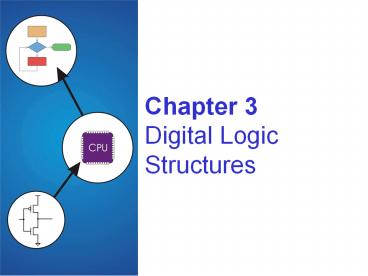Chapter 3 Digital Logic Structures - PowerPoint PPT Presentation
Title:
Chapter 3 Digital Logic Structures
Description:
Title: Transistors and Logic Gates Author: Greg Byrd Last modified by: Karl Ricanek Jr. (Director, ISIS) Created Date: 5/30/2000 2:34:32 PM Document presentation format – PowerPoint PPT presentation
Number of Views:95
Avg rating:3.0/5.0
Title: Chapter 3 Digital Logic Structures
1
Chapter 3Digital LogicStructures
2
Transistor Building Block of Computers
- Microprocessors contain millions of transistors
- Intel Pentium 4 (2000) 48 million
- IBM PowerPC 750FX (2002) 38 million
- IBM/Apple PowerPC G5 (2003) 58 million
- Logically, each transistor acts as a switch
(open/closed) - Combined to implement logic functions
- AND, OR, NOT
- Combined to build higher-level structures
- Adder, multiplexer, decoder, register,
- Combined to build processor
- LC-3
3
Simple Switch Circuit
- Switch open
- No current through circuit
- Light is off
- Vout is 2.9V
- Switch closed
- Short circuit across switch
- Current flows
- Light is on
- Vout is 0V
Voltage source
Switch-based circuits can easily represent two
states on/off, open/closed, voltage/no voltage.
4
n-type MOS Transistor
- MOS Metal Oxide Semiconductor
- two types n-type and p-type
- n-type
- when Gate has positive voltage,short circuit
between 1 and 2(switch closed) - when Gate has zero voltage,open circuit between
1 and 2(switch open)
Gate 1
Gate 0
Terminal 2 must be connected to GND (0V).
5
p-type MOS Transistor
- p-type is complement to n-type
- when Gate has positive voltage,open circuit
between 1 and 2(switch open) - when Gate has zero voltage,short circuit between
1 and 2(switch closed)
Gate 1
Gate 0
Terminal 1 must be connected to 2.9V.
6
Logic Gates
- Use switch behavior of MOS transistorsto
implement logical functions AND, OR, NOT. - Digital symbols
- recall that we assign a range of analog voltages
to eachdigital (logic) symbol - assignment of voltage ranges depends on
electrical properties of transistors being used - typical values for "1" 5V, 3.3V, 2.9V
- from now on we'll use 2.9V
7
CMOS Circuit
- Complementary MOS
- Uses both n-type and p-type MOS transistors
- p-type
- Attached to voltage
- Pulls output voltage UP when input is zero
- n-type
- Attached to GND
- Pulls output voltage DOWN when input is one
- For all inputs, make sure that output is either
connected to GND or to ,but not both!
8
Inverter (NOT Gate)
2.9v
In Out
0 1
GND
In Out
1 0
In Out
0v 2.9v
2.9v 0v
Truth table
9
NOR Gate (OR-NOT)
Truth table
A B C
0 0 1
0 1 0
1 0 0
1 1 0
Note Serial structure on top, parallel on bottom.
10
OR Gate (NOR-NOT)
NOR
A B C
0 0 1
0 1 0
1 0 0
1 1 0
OR NOR-NOT
A B C
0 0 0
0 1 1
1 0 1
1 1 1
NOT
NOR
Add inverter to NOR.
11
NAND Gate (AND-NOT)
A B C
0 0 1
0 1 1
1 0 1
1 1 0
Note Parallel structure on top, serial on bottom.
12
AND Gate
A B C
0 0 0
0 1 0
1 0 0
1 1 1
NOT
Add inverter to NAND.
NAND
13
Basic Logic Gates































